
|
|

August 1, 2008
The Big Trip 2007, part XIII: The AM Towers of Boise, Idaho
It's become an annual tradition here at Tower Site of the Week - load up the tape decks and the DVD recorders and the cameras, line up a bunch of station tours, gather a few friends, and hit the road for as much as two weeks of in-depth exploration of the radio and TV environment in some scenic part of this great nation of ours. Then we come home and share it all with you, in pictures here on fybush.com and in audio (of legal IDs) over at our sister site, tophour.com.
"Big Trip 2007" covered parts of Utah, Wyoming, Idaho, Montana, Washington and Oregon over two weeks in late August and early September.
Days Eight, Nine and Ten - Friday, August 31 - Sunday, September 2, 2007
In last week's installment, we showed you all the studios we visited during our long weekend in Boise. This week, we take you to the AM towers around the market.
Boise itself sits at the eastern end of the Treasure Valley, which stretches more than 50 miles from Ontario, Oregon to the foothills that mark the eastern boundary of the city. Nearly all its AM stations, though, are located in a cluster of towers south and west of the city, and it's there that we'll spend most of this installment.
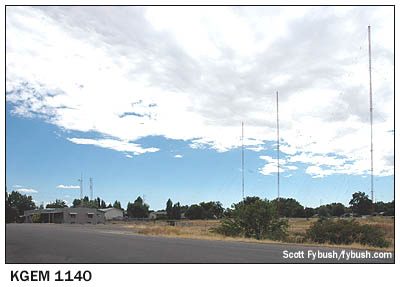
|
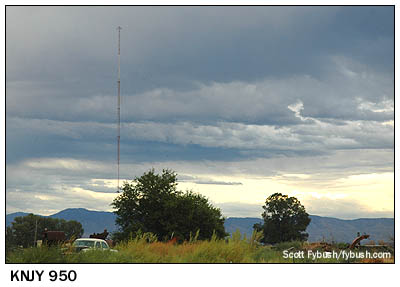
|
Before we get down to the tower farm, though, let's show you three AM sites that sit in other parts of the Boise metro area.
Journal's KGEM (1140 Boise) is the closest AM site to downtown Boise, with three towers near the corner of Cassia Street and Curtis Road on the city's west side, just a couple of miles west of downtown. At one time, the station's studios were in the building here at 5601 Cassia, and I think the top-loaded three-tower array (10 kW day and night, non-directional days, all three towers at night) is original to KGEM's 1946 debut. (The calls, of course, come from Idaho's nickname as "The Gem State.")
Heading west, the only other Boise-licensed AM located north of I-84 is KNJY (950), which runs 3500 watts days and 40 watts at night from a single tower on North Canada Road, just across the Canyon County line and about 12 miles west of downtown. This one started out on 1010 in 1961, when it signed on as KATN, "K-Ten," and moved to 950 after that frequency was vacated in 1968. (We'll get to that story in a bit.)
It's about four miles north from KNJY to KBGN (1060 Caldwell), another station that signed on around the same time, in this case with 10 kW non-directional, daytime only. Those are FM bays up on the KBGN tower, a former aux for what's now KBXL (94.1), which now transmits from the Deer Point tower farm that will be the subject of next week's installment.
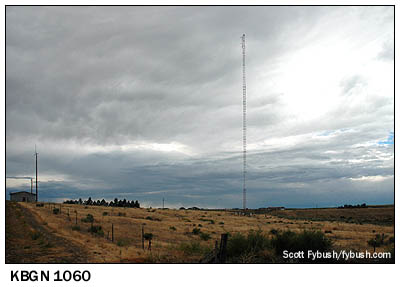
|
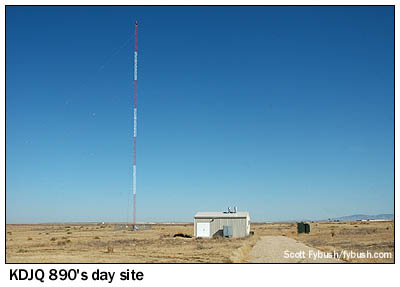
|
We'll come back out to this end of the valley in a bit, but before we do, let's tackle the tower farm southwest of Boise. We'll start with the newest site here, recent sign-on KDJQ (890 Meridian), running 50 kW by day from this single tower on Kuna-Mora Road, about seven miles almost due south of downtown Boise. (Yes, this compact city really does turn into empty desert this close to downtown heading south; all of the sprawl is concentrated along the I-84 corridor going west.)
KDJQ was doing Spanish-language programming when we visited; it would go silent a few months later, with the owners listing the station for sale on eBay. At this writing, almost a year later, it's still silent, though a sale to a Catholic broadcaster is pending.
KDJQ does have night power, but not from the Kuna-Mora Road site; instead, its 250-watt night signal reaches Meridian from a site about six miles to the northwest, at the corner of Lake Hazel and Linder Roads. This site is owned by Citadel, and its primary occupant is sports station KTIK (1350 Nampa), which runs 5 kW days and 600 watts at night here. KTIK has been on 1350 only since 2000; before that, it was a graveyarder on 1340, operating from one of the towers here, and before that from a site closer in to Nampa.
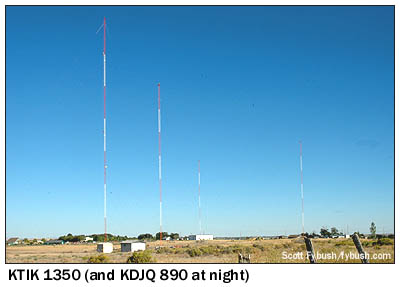
|
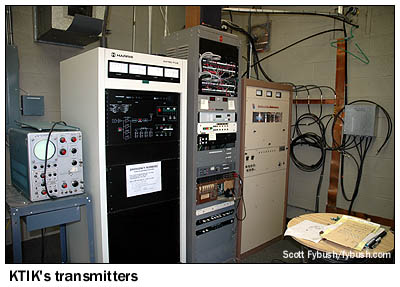
|
KTIK's site sits within view of another four-tower array, the oldest site in this tower farm. KFXD was running just 250 watts day, 100 watts at night on 1200 when it built a self-supporting tower on Amity Road in 1935. That's the tower seen second from right in the photo below. In 1946, KFXD (by then on 1230, thanks to the NARBA frequency shifts of 1941) built a second self-supporter to hold the antenna of the short-lived KFXD-FM, and in 1947 KFXD moved to 580, running 1000 watts from both towers. In 1952, the final two towers were added, and 580 settled down with the facilities it still uses today - 5000 watts, directional at night.
Most of the Boise radio folks we met still call this the "KFXD site," even though in 2002, Clear Channel swapped calls and formats between KFXD and KIDO (630 Boise), moving KIDO's higher-rated news-talk programming to the better 580 signal.
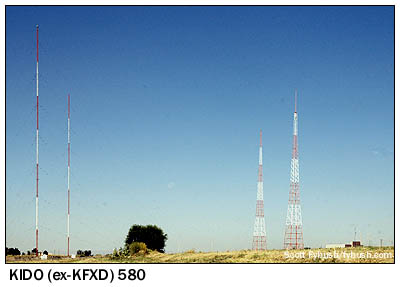
|
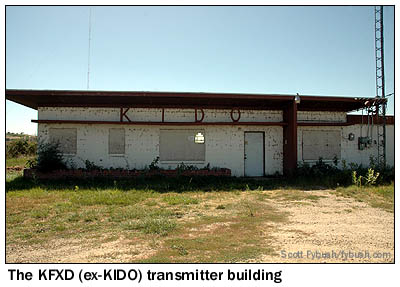
|
It's only a couple of miles, as the crow flies, from the 580 site to the 630 site on Cloverdale Road, more or less at the center of the AM tower farm. The transmitter building still says "KIDO" on it (it was used for a while as the studio location, too, after KIDO-TV was sold off in 1959 and became KTVB), and the three towers make up one of the most widely-spaced arrays in the country. This is also a 5 kW full-timer, but as a fairly late arrival on 630 (it came to the channel in 1951, after earlier operating on 1350 and 1380), it operates directionally both day and night. At night, in particular, its three-lobed pattern (it protects CHED in Edmonton, the former KOH in Reno and KHOW in Denver) has a deep null over the Nampa area, which includes some of the faster-growing parts of the market. The "new" KIDO on 580, by contrast, blankets that area day and night.
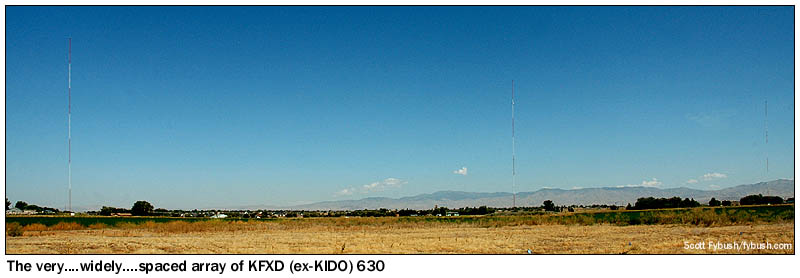
We should note, too, that this site has a second AM signal diplexed on it. Boise State University's KBSU (730 Boise) used to be commercial daytimer KYME, operating on 740 from a site closer into the city that's now a shopping mall. It runs 15 kW days, 500 watts at night from all three towers, and had recently traded a jazz format for news and information when we arrived in town. (Boise State also operates two other public radio services, one with classical music on KBSU-FM 90.3 and one with news and talk on KBSX 91.5; all three services have relay transmitters elsewhere in the state, too, as we'll see later on.)
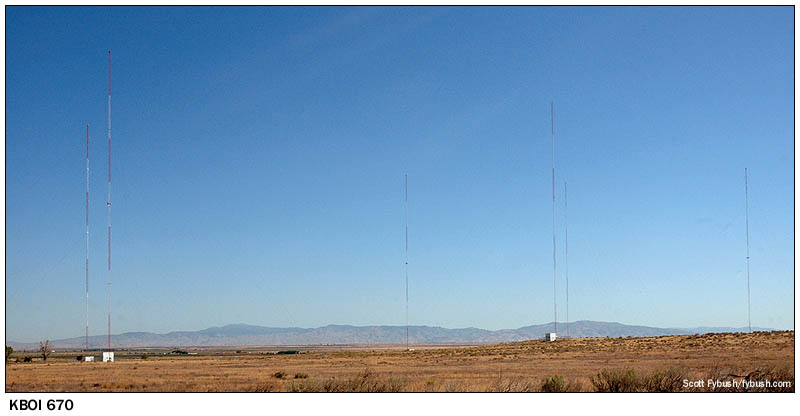
Another five miles or so down Cloverdale Road brings us to Boise's most powerful AM signal. KBOI (670 Boise) booms out with 50,000 watts, day and night, from these six 367-foot towers, and behind them is a fascinating history indeed.
In 1947, Dee and Sol Haas put KDSH on the air at 950, broadcasting with 1000 watts from a site on Eagle Road in Meridian, presently occupied by St. Luke's Hospital. The original transmitter was a Western Electric that was venerable even then, purchased (very) used from KOAC in Corvallis, Oregon. KDSH quickly upgraded to 5000 watts, adding a third tower across Eagle Road, and in 1955 changed calls to KBOI to match its new sister station, KBOI-TV (Channel 2, now KBCI).
With the breakdown of the eastern clear channels, KBOI owner Queen City Broadcasting applied to move the station from 950 to 670, and after legal battles with NBC (which didn't want to see the clear channel occupied by its WMAQ, Chicago broken up) and KGEM (which hoped to remain the highest-powered station in town), KBOI was finally granted the move down the dial, which it carried out to much fanfare in the summer of 1968.
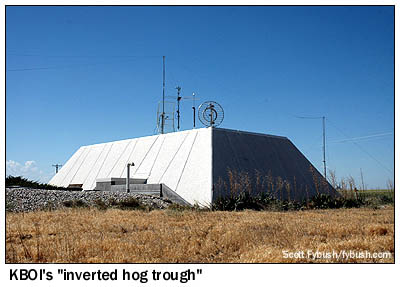
|
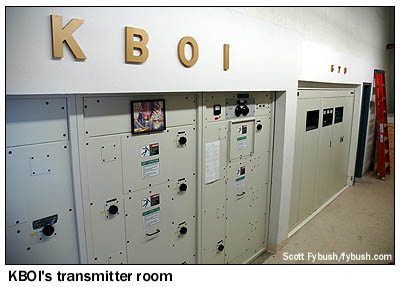
|
There still survives a promotional film made at the time of the power increase, boasting of KBOI's ultra-modern, state-of-the-art concrete transmitter building, designed with sloping walls so that it had a low profile and wouldn't affect the antenna system. (Legend suggests that there was another reason, too - this was the Cold War era and there was some idea that radioactive fallout would run down the sides of the building without sticking; a FEMA report years later would conclude that radioactive material would build up on the sloping walls instead, creating an even greater hazard. Thankfully, the question has never been put to practical test.)
Yes, there's also a fallout shelter in the basement - and, yes, the "ultra-modern" architecture of the late sixties is described, four decades later, as an "inverted hog trough" by certain Boise engineers of our acquaintance...
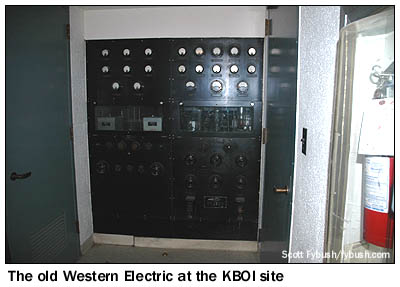 Inside,
the main transmitter is a Harris DX50, but there's some much
older iron here, too. That Western Electric that put KDSH on
the air back in 1947, after many years of service at KOAC, was
moved down here when this site was built. It's not connected
to anything, but it sure does make for a pretty view walking
in the front door.
Inside,
the main transmitter is a Harris DX50, but there's some much
older iron here, too. That Western Electric that put KDSH on
the air back in 1947, after many years of service at KOAC, was
moved down here when this site was built. It's not connected
to anything, but it sure does make for a pretty view walking
in the front door.
This site was heavily reconstructed in 2000, when Lotus wanted to improve the night signal of another station on 670, KIRN in Simi Valley, California.
To allow KIRN to move to a new transmitter site in the high desert northeast of Los Angeles, Lotus paid to redesign the KBOI night array, replacing three of its original four towers with five new towers. Instead of blanketing most of the west at night (your editor fondly remembers listening to KBOI's music shows, in AM stereo no less, from along the California/Nevada border in the late eighties), KBOI now has a null toward California, aiming most of its signal north and west. It's still a booming signal into Oregon and Washington, and by far the best AM signal in the market; it's a tribute to the forethought of KBOI's engineers in the sixties that they sited this facility far enough south that all the population growth has remained north of these towers.
(Ironically, KIRN never did get around to building its proposed new array up near Palmdale, California, after going to all that trouble to rebuild KBOI.)
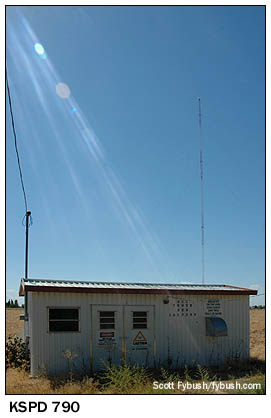
|
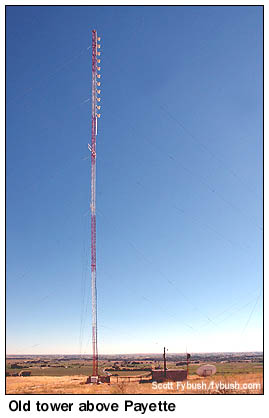
|
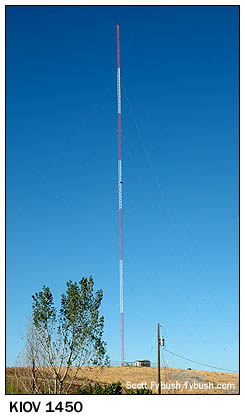
|
There's but one other site down here in the tower farm: returning to civilization on Cloverdale, we head north past KIDO - er, KFXD - and spot little KSPD (790 Boise) off to the side on Bott Road. "K-Spud" (we are in Idaho, after all) runs 1000 watts by day, 63 watts at night, and we thought those rays of sun shining into the picture were sort of appropriate, since it's a religious station.
We'll finish off with some sites at the western edge of the Treasure Valley, some of them as much as 50 miles west of Boise. Payette sits on the Oregon border, and until just last year, it had its own AM station, KIOV (1450). KIOV's old tower still stands on a hill overlooking Payette, a few miles north on US 95 from the last Idaho exit on I-84; thw tower was also once used by Payette's FM station, KQXR (100.3), which moved a few years back to Freezout Hill near Emmett, Idaho, north of Nampa, giving it a booming signal into Boise. (It's part of Journal's cluster, doing modern rock as "the X.")
Later, the tower was used by KSRV-FM (96.1), licensed to Ontario, Oregon, as the first step in its move-in to the Boise market. KSRV put those bays on the Payette tower, then left them behind when it moved to Deer Point a few years ago - and we'll see that site, too, next week.
A few months before our visit, KIOV changed city of license to Notus, Idaho, and its new tower sits right off I-84, 15 miles east of the state line and about 36 miles west of Boise. Thanks to decent ground conductivity, its 1 kW is quite listenable in most of the market by day. (It programs mostly Sporting News Radio.)
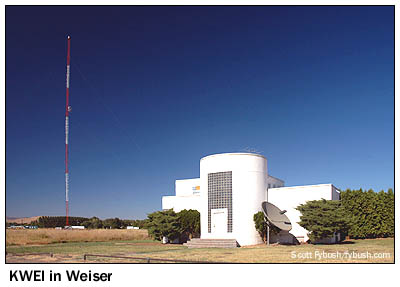 |
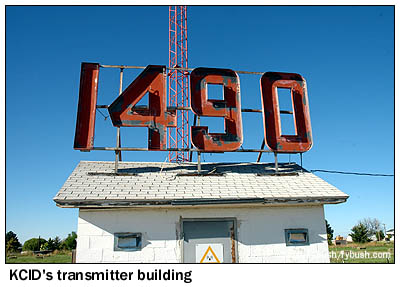
|
We wrap up this installment of our Boise tours with two especially scenic AM sites at the western end of the valley.
It's another ten miles or so north from Payette to the small town of Weiser, Idaho (they say it "weezer," like the band), and it's just south of downtown Weiser that US 95 passes the lovely Art Deco building that's home to KWEI (1260). When the station came on the air in 1947 (we're guessing the building is original to that era), KWEI was speaking English; of late, it's become a Spanish-speaking outlet, catering to an increasing number of Hispanics in the area, and with KWEI's 10 kW non-directional day power, it puts a usable signal into Boise, more than 65 miles to the southeast.
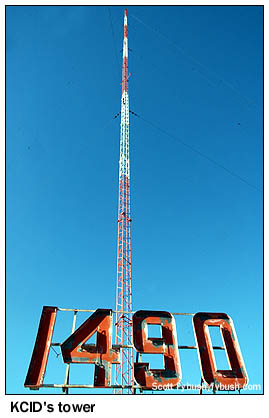 KWEI
also has an FM station, KWEI-FM (99.5 Fruitland), rimshotting
Boise from some 30 miles to the north; I'm told the AM programming
actually gets to the site in Weiser from its studios in Boise
via a subcarrier on the FM signal.
KWEI
also has an FM station, KWEI-FM (99.5 Fruitland), rimshotting
Boise from some 30 miles to the north; I'm told the AM programming
actually gets to the site in Weiser from its studios in Boise
via a subcarrier on the FM signal.
Returning to Boise, we make one final AM stop, just east of Caldwell, Idaho, the westernmost major city in the Treasure Valley. From Caldwell, there are two roads back to Boise, 30 miles away - the southern route via I-84 or the northern route via US 20. Heading east from Caldwell on 20, one of the first intersections is KCID Road, and it's there that we find - no surprise here - KCID (1490 Caldwell).
This is part of Journal's cluster, operated from the studios in Boise with a satellite standards format, but it had studios in downtown Caldwell as recently as the early nineties, and back in the days when US 20 was the main road east from Caldwell through to Nampa and Boise, that big red "1490" sign that now crowns the transmitter building (reached by a driveway behind a house on KCID Road) must have been a prominent sight for drivers zipping past.
In any event, it's a fitting place to wrap up our tour of the Boise AM landscape, especially since there's nothing higher on the dial, at least for now. That could change someday; the AM application window in 2005 produced a slew of proposals for new AM signals out here, aided immensely by the simple fact that it's a very long way from Boise to just about anywhere, leaving several holes for sizable new stations. There's already one granted CP, for 50 kW days/1 kW nights on 1430 from a site just south of the KTIK towers, and applications all over the place for stations on 540, 990, 1010, 1020, 1100, 1200, 1220, 1230 and 1590.
Can Boise support all that radio? We don't know - but we know that when and if these new signals sign on, our friends at the History of Idaho Broadcasting Foundation will be there to chronicle them, and we're grateful to them for a lot of the historical information that went into this installment.
Next Friday, we'll wrap up our Boise visit with a look at the Deer Point FM/TV site high above the city. And in the meantime, stop by Tophour.com next Wednesday to hear the second of three installments of Boise IDs.
Tower Site Calendar 2008 is almost sold out! Visit the Fybush.com Store now and get your calendar now!
- Previous Site of the Week: Big Trip 2007 Part XII - The Studios of Boise
- Next Week: Big Trip 2007 Part XIV - Boise's Deer Point TV/FM Site
- Site of the Week INDEX!
- How can you help support Site of the Week? Click here!
- Submit your suggestions for a future Site of the Week!
